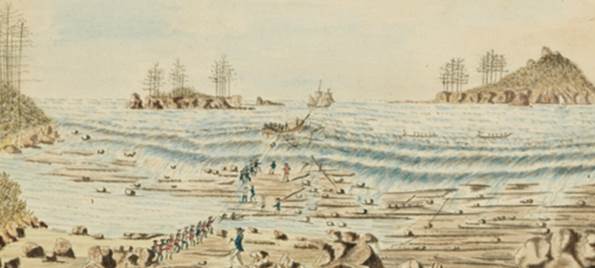Born 1758 Portsmouth England, he was baptised 14 November 1758 St Thomas’ Portsmouth, England, son of John and Elizabeth BRADLEY. Occupation: Artist, Map Maker. William married Sally WITCHELL, 24 February 1787, Saint Faith Havant, Hampshire, England. His was appointment to First Lieutenant HMS Sirius on 25 October 1786, Crew Number 2, aged 28 years.
Warrants or commissions for service at this rank in the Royal Navy, 25 October 1786: Arthur Phillip, Captain; William Bradley, 1st Lieutenant; Philip Gidley King, 2nd Lieutenant; George William Maxwell, 3rd Lieutenant; Daniel Manning, boatswain; Peter Ross, gunner; Charles Parker, carpenter; Edward Norman, boatswain; Robert Hope, purser; James Lockhart, purser; Robert Hope, purser; John Lawford, 1st Lieutenant.
William was stranded on Norfolk Island, mustered 20 March 1790 on Norfolk Island after the shipwreck. First Lieutenant William Bradley and Second Lieutenant, Newton Fowell along with other members of HMS Sirius crew remained overnight aboard the ship, after the wreck. Whilst on Norfolk Island he undertook many surveys and completed maps of the Island, along with a range of landscape sketches include that of HMS Sirius shipwreck. William Bradley kept a journal of his travels with the First Fleet and his time in Sydney and Norfolk Island from December 1786 to May 1792 titled “A Voyage to New South Wales“ which is held in the Mitchel Library First Fleet Collection”.
In his journal Bradley describes how after HMS Sirius shipwreck that all hands-on board brought up as much as possible provisions, supplies, chest to the gun deck in case an opportunity was found to float then ashore. Upon deciding to quit the ship, the crew were able to get a hawser from the ship to the shoreline, with a wooden heart upon it for a traveller by means of a cask floating a rope over the reef and through the surf, which those on shore hauled the end of the hawser and secured around a pine tree, with the other end being on board the ship was hove taut.
The ships company was hauled ashore though the surf to the reef, from which they crossed to the shore in a small boat positioned inside the reef. William Bradley remarked how many of the crew members were nearly drowned and being quite senseless for a time after being rescued. The Governor Robert Ross positioned guards on the roads which led round the Island, so that no one could go anywhere without a pass, Captain Hunter ordered William Bradley to give HMS Sirius seamen a pass whenever they called upon him for one with no restrictions. Bradley continues with his writings about his time with fellow stranded crew members of HMS Sirius, the joy of seeing the Justinian and the Surprize arriving in August 1790 and the disappointment of not being removed from Norfolk Island by these ships.
On 4 February 1791, HMS Sirius seaman Jacob Nagle was walking along the beach, casting his eyes along the Island he saw a ship, his heart leaped within him as he raced down to the flagstaff, where HMS Sirius 1st Lieutenant William Bradley spent his days. The whole township was alarmed, and two boats were launched, being fine weather and little wind, and idea landing conditions to welcome HM Supply arrival to Norfolk Island. William returned to Sydney aboard HM Supply and disembarked on 26 February 1791. He then embarked on the Dutch vessel Waaksamheid for England, leaving the colony on 27 March 1791.
In England William was one of HMS Sirius officers who were court martialed aboard HMS Brunswick over the loss of HMS Sirius. William Bradley wrote on his return to England:
April Friday. 27th: A Court Martial was held on board of the Brunswick to try Capt. Hunter, the Officers & Crew of the Sirius for the loss of the said Ship; when it appear’d that everything was done, that could be done; to save the Ship; Capt. Hunter, the Officers & Crew were Honorably Acquitted & removed from the Waakzaamheydt (sic) to the Admiral’s Ship, where they were paid off the 4th May 1792.
Following Governor Phillip’s request, Bradley was promoted to the rank of Master and Commander, in July 1792.
SECRETARY STEPHENS TO GOVERNOR PHILLIP. Per store-ship Bellona; ‘received by Lieut.-Governor Grose 16th January 1793. Sir, Admiralty Office, 20th July, 1792.
Their Lordships, in consideration of the services of Lieut. Bradley and Mr. Henry Waterhouse, have been pleased to promote the former to the rank of master and commander, and have signed a commission giving the latter the rank of a lieutenant, and have ordered him to be paid for the time, he acted as third lieutenant of the Sirius, when Lieut. Maxwell was discharged from that ship. PHILIP STEPHENS.[6]
In the 1796 William was on the ship Inconstant. William rose to the rank of Rear Admiral of the Blue and was superannuated in September 1812. William died 13 March 1833 France.
Image: Part of the Reef in Sydney Bay, Norfolk Island, on which the Sirius was wreck’d. 19 March 1790, William Bradley. Mitchell Library NSW.
 William Bradley’s Journals and Log
William Bradley’s Journals and Log
- A Voyage to New South Wales, The Journal of Lieutenant William Bradley, RN of HMS Sirius 1786 – 1792. 1 volume – manuscript, 29 drawings – (bound or hinged) – watercolour, Drawings – 22 charts, 14 maps (disbound)
- Scans and index of Journal
- Acquiring William Bradley’s Log
- The log is a precise record of the voyages of HMS Sirius
References: TNA, ADM 6/23/363; Jacob Nagle, Jacob Nagle his Book A.D. One Thousand Eight Hundred and Twenty Nine May 19th. Canton. Stark County Ohio, 1775-1802; Phillip Gidley King, Journal of Philip Gidley King: Lieutenant, R.N. 1787-1790; William Bradley, A Voyage to New South Wales, The Journal of Lieutenant William Bradley, RN of HMS Sirius 1786 – 1792; HRA, series 1, vol. 1: 368.
